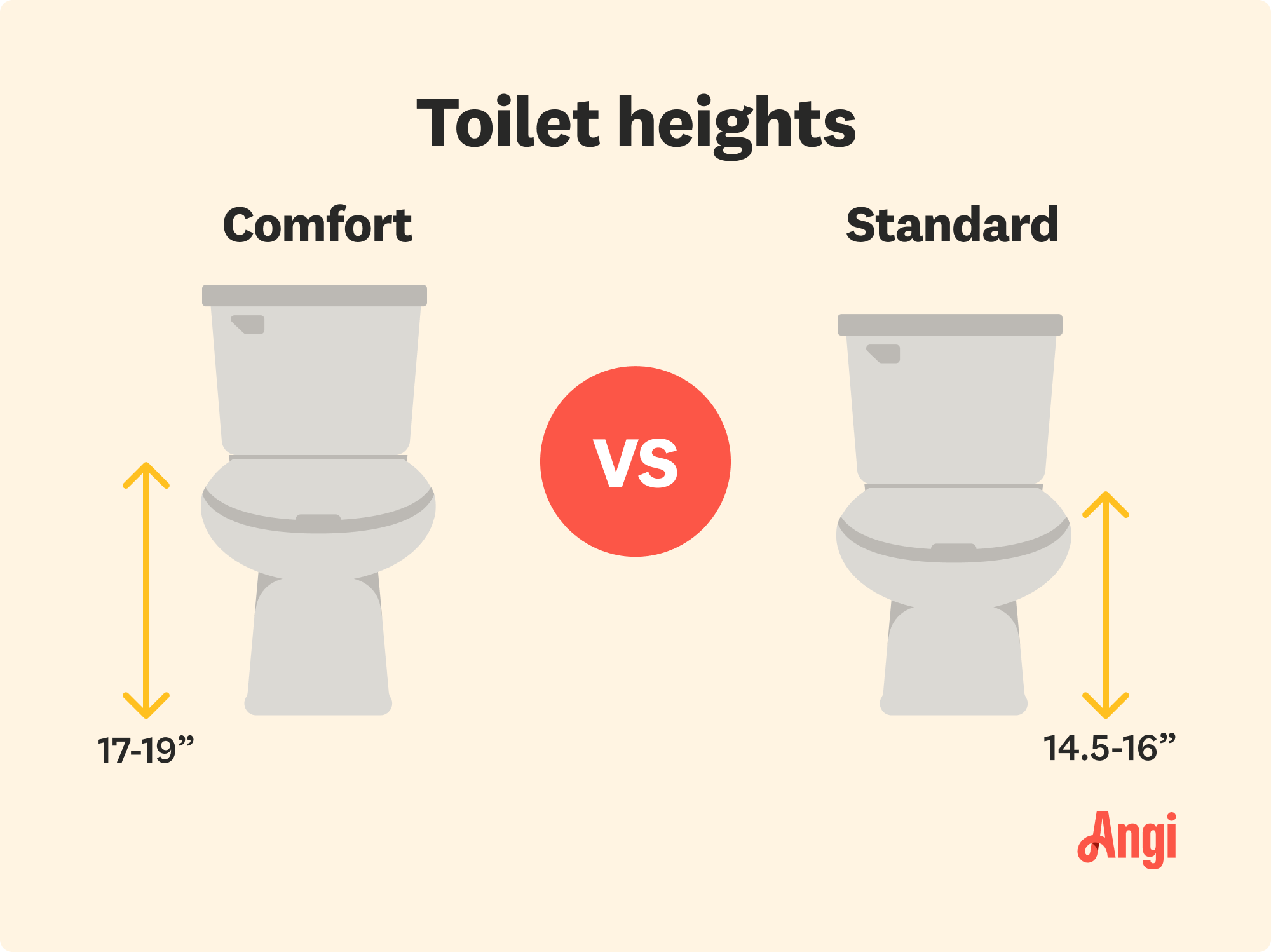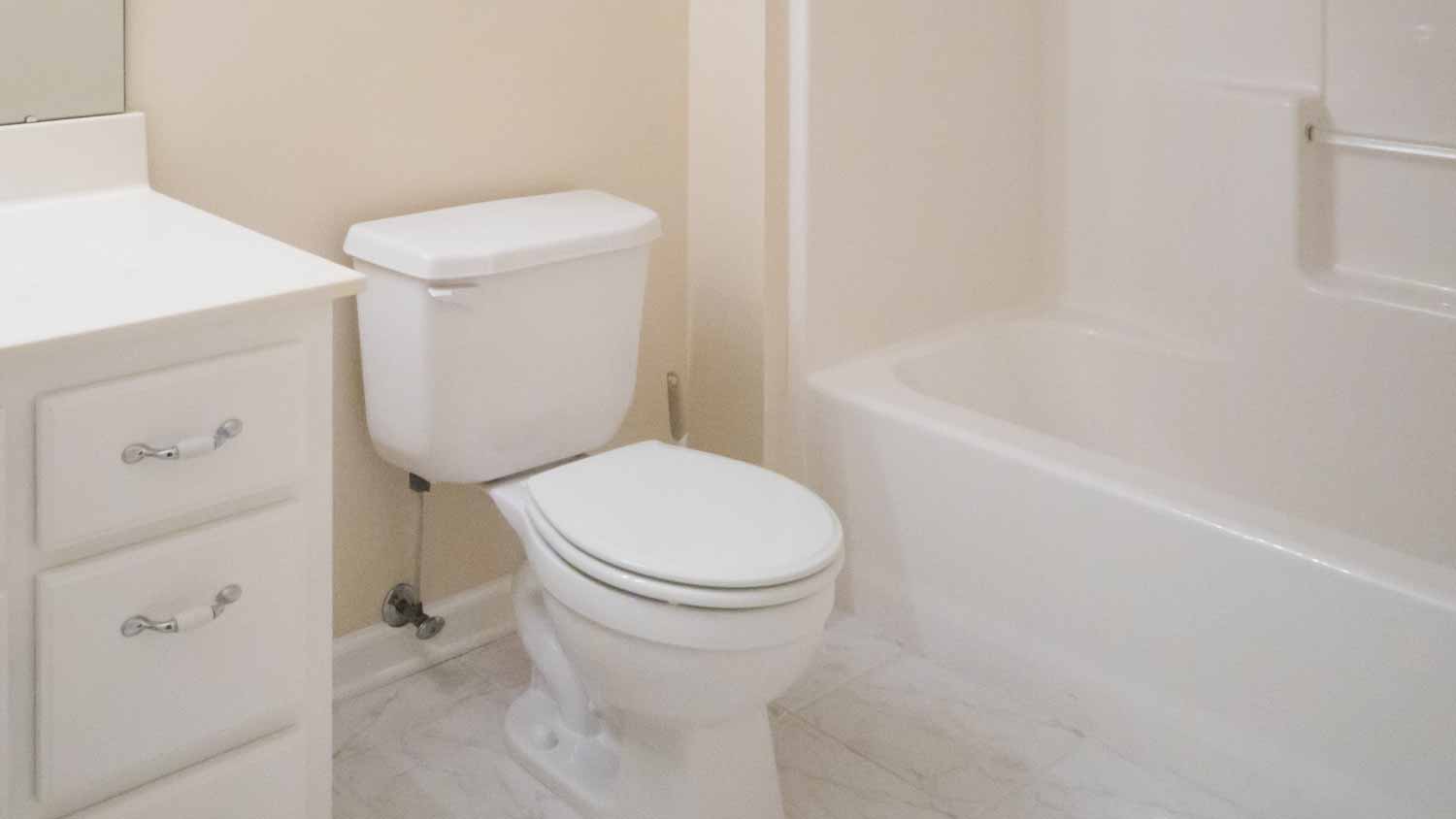A Total Guide to Toilet Dimensions and How to Measure for Your Space
Toilets don’t have standardized dimensions, but there is a common range


More homeowners are opting for comfort height toilets (which are taller) versus standard toilets.
Accessible toilets must have a seat height between 17 and 19 inches.
For small bathrooms, avoid elongated toilets, which have a larger depth.
Consider the size of your space and the user when choosing a toilet.
If you’re remodeling your bathroom, it’s easy to get carried away with walk-in shower designs and paint colors, but don’t forget to keep comfort and utility in mind. The right size toilet can make a bathroom more accessible—but pick the wrong size, and you may be looking at some costly fixes. Since toilets don’t have standard dimensions, you need to measure your space to get it right. This guide will tell you everything you need to know about toilet dimensions.
What Are the Standard Toilet Dimensions?
Toilet dimensions aren’t standardized, but there is a typical range. Most toilets have a depth between 25 and 32 inches, depending on whether they have a round or elongated bowl. The average toilet width is 20 inches, with most toilets ranging from 13 to 21 inches at the widest point. Depending on the tank, toilet height falls between 27 and 32 inches, with seat heights between 15 and 19 inches.
The rough-in measurement is the final (and perhaps most important) consideration. This is the distance between the center of the toilet flange (the toilet drainpipe) and the wall where you’ll install your toilet. Most toilets have a 12-inch rough-in, though you can also find 10-inch and 14-inch rough-ins.
| Toilet Size | Toilet Dimensions |
|---|---|
| Small | Depth: 25”–27”, Width: 13”–16”, Height: 27–32”, Rough-in: 10”–14” |
| Medium | Depth: 28”–30”, Width: 14”–20”, Height: 27”–32”, Rough-in: 10”–14” |
| Large | Depth: 30”–32”, Width: 15”–21”, Height: 27”–32”, Rough-in: 10”–14” |
Toilet Seat Heights

The height of your toilet seat has one of the greatest impacts on overall comfort. Most people choose from either standard height or comfort height (though sometimes, you can get an extra-tall or a custom height toilet). Comfort height is more accessible and often used in universal bathroom design. Standard height is the most common, though it’s fallen out of favor in recent years.
Standard Toilet
A standard toilet has a seat height between 15 and 17 inches. Some manufacturers list the bowl height without the seat, which is between 14 1/2 and 16 inches, since the seat can add 1/2 inch or more.
Standard toilets are more comfortable for families with children, who may find climbing up on a shorter bowl easier.
Comfort Height Toilet
Comfort height toilets (also known as chair height toilets) have a taller seat height of 17 to 19 inches (or a bowl height of around 16 1/2 inches without the seat). This height is more accessible for older adults, taller individuals, and people with mobility issues.
For compliance with the Americans With Disabilities Act (ADA), your toilet seat must be 17 to 19 inches off the ground (measured from the top of the seat). If you’re looking to install an accessible bathroom, call a toilet installer near you who understands the regulations.
Toilet Sizes by Bowl Shape

There are a handful of different toilet seat types with slightly different dimensions. The most common are round or elongated. Though there are no standard sizes, elongated bowls are about 2 inches longer than round bowls.
| Type of Toilet Bowl | Average Length (Inches) |
|---|---|
| Round | 16 1/2 |
| Elongated | 18 1/2 |
Round
Round toilet bowls are around 16 1/2 inches long. These are ideal for smaller bathrooms since they take up less space. They’re also more comfortable for children and smaller adults but can be uncomfortable for taller adults.
Elongated
Elongated toilet seats come in different sizes, but most are around 18 1/2 inches long. Because of their slightly longer length, these are more comfortable for taller adults and more accessible. On the flip side, they take up more space and tend to come with a higher price tag.
How to Measure a Toilet

Before you replace your toilet, measuring the size to know what will fit in the existing space is essential to a successful bathroom remodel or upgrade. The key measurements are height, depth, width, and the rough-in measurement.
Height
There are two different height measurements you’ll need. First, obtain the overall height measurement to ensure your toilet will fit beneath any shelving, cabinets, or storage racks on your wall.
You’ll also need the seat height measurement to choose the most comfortable toilet for your household. Grab a measuring tape and use these instructions to measure toilet height:
Overall height: Measure from the top of your toilet tank to the floor.
Seat Height: Measure from the top of the seat to the floor.
Depth
To determine your toilet's depth, measure from the front of the rim to the back of the tank. You’ll need at least 21 inches of clearance in front of the toilet, though 30 inches is ideal.
Width
You’ll want to measure the width of your toilet at the widest point. Sometimes, this is the width of the toilet tank—but not always. Some models have a slimmer, space-saving tank. In that case, you’ll want to measure the width of your bowl. Ideally, measure both and choose whichever measurement is bigger. You’ll need at least 30 inches of space to accommodate your toilet (15 inches on each side, measured out from the center).
Rough-In Measurement
Measuring the toilet rough-in will ensure enough space between the wall and the drainpipe to accommodate the back of your toilet and the tank. To get the size, look for the small bolt on the base of the toilet. Use a measuring tape to measure the distance between the center of the bolt and the bare wall (avoid moldings and baseboards). The standard measurement is 12 inches, though it may be 10 or 14 inches.
Choosing the Right Size Toilet
Since toilet sizes vary, it's best to measure your bathroom in advance. Once you’ve collected the necessary information, you can shop more intentionally. Here are a few things to consider when picking the best toilet for your house.
Size of Space
For proper toilet clearance, you’ll need at least 21 inches in front of your toilet and 15 inches on either side (measured from the center of the toilet). However, these are only minimums and are often not the most comfortable or accessible option.
Before you choose a toilet size, evaluate the size of your space and any potential obstructions. Don’t forget to account for the door if it opens into your bathroom. Round toilets are ideal for small bathrooms, but you may even be able to opt for a tankless option. Call a pro who replaces toilets to help you understand your choices.
Your Household
Who’s primarily using your bathroom? Different toilet dimensions suit different people. If you’re taller, plan to age in place, or have mobility issues, consider installing a comfort height toilet with an elongated bowl. If you have young children, you may want to stick with a standard toilet.
Your Existing Plumbing
For most homeowners, toilet installation costs $225 to $550. Those costs could quickly skyrocket if you need to move plumbing. Consider the location of your existing plumbing—especially the rough-in distance—to avoid added work and costs.
Type of Tank
There are several different types of toilets. The most common are two-piece toilets, in which the bowl attaches to the base of the tank. You’ll also find one-piece toilets, in which the tank and bowl are a single element. These tend to take up less space and have a more modern design.
To shrink things even further, consider a wall-hung toilet, which hides the flushing mechanism behind a wall. High-tank toilets are less popular but can save floor space in exchange for wall space.





- Gas Plumbers
- Plumbing Repairs
- Sump Pump Installation
- Wood & Pellet Stove Repair
- Shower Repair
- Wood Stove Services
- Emergency Plumbers
- Fire Sprinkler Contractors
- Perc Test Companies
- Toilet Repair & Installation
- Boiler Repair
- Sewer Line Repair
- Faucet Repair
- Main Drain Camera Companies
- Foundation Drain Installation
- French Drains
- Bathtub Replacement
- Subcontractors
- Storm Drain Contractors
- Affordable Plumbing
- Plumbing & Heating Companies
- Bathroom Repair Services
- Sink Installation
- Commercial Plumber
- Barndominium Builders
- Water Line Repair
- Faucet Installation
- Water Line Installation
- Leak Detection
- What’s the Difference Between Standard Height and Comfort Height Toilets?
- 12 Types of Toilets to Upgrade to in Your Bathroom Remodel
- Toilet Rough-In Dimensions: A Complete DIY Guide to Measure a Toilet
- 10 Toilet Facts That’ll Make You Appreciate Your Commode More
- 7 Best Tips for Cleaning a Toilet
- Who Should You Call to Replace a Toilet?
- Is Your Toilet Wobbly? Stop the Shake With These 3 DIY Solutions
- How a Toilet Flushes: Find Out What Happens After You Flush
- 6 Reasons Why Your Toilet Is Leaking at the Base
- 6 Ways to Unclog Your Toilet Without a Plunger










